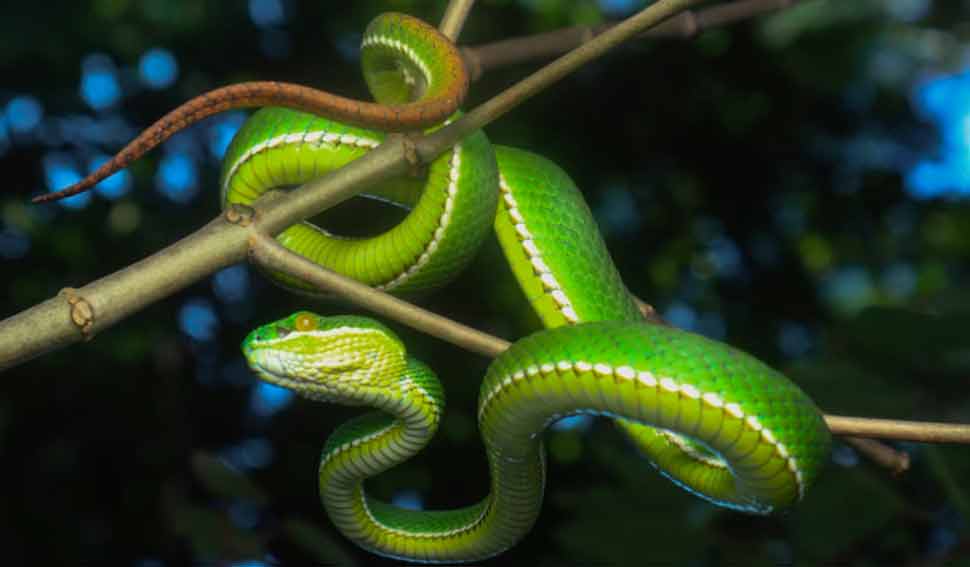Mizo researchers record new pit viper species in Indian soil

For the first time, a team of five researchers from Mizoram University reported the existence of a pit viper species – Trimeresurus uetzi (MZMU333) from Indian soil.
The species is so far known from central and southern Myanmar but unrecorded from India.
“We report the occurrence of Trimeresurus uetzi in Mizoram, which was recently described from Myanmar. We established the identity of the specimen based on morphological characters according to the original description of the species. This report represents a new country record of the species from India as well as a range extension of the species northwestward from the known records in Myanmar,” said HT Lalremsanga, Head of Zoology, Mizoram University.
“The new revelation added the already known total Trimeresurus viper species 20 to 21 for the country showing the biodiversity richness of India,” Lalremsanga said.

The research paper of five researchers- Lal Biakzuala, Lal Muasanga, Fanai Malsawmdawngliana, Lalrinnunga Hmar and HT Lalremsanga was first published in an international journal “Journal of Threatened Taxa” on May 26.
The genetic studies showed the paraphyly of T albolabris group and the distribution range of T albolabris sensu stricto was subsequently restricted to southeastern China and northeastern Vietnam.
“The live snake is not the Aizawl voucher specimen, but an uncollected male, sighted in Reiek Community Reserve Forest, some 5 km aerial distance west of Mizoram University campus – the collection site of MZMU 3333. We also attribute this individual to T. uetzi, as it possesses 21 dorsal mid-body scale rows, green gold colored iris; a grass-green dorsum and yellowish-green venter; a white postocular streak from the anterior margin of the nasal scale that connects posteriorly to the white dorsolateral stripe at the corner of the mouth, plus lack of red stripes on facial and ventrolateral regions,” Lalremsanga said.
Trimeresurus uetzi is a species so far known from central and southern Myanmar but unrecorded from India. The present specimen MZMU 3333 from Aizawl, thus represents the longest male recorded so far, 612 mm in total length against the existing maximum total length 591 mm and forms the first record of this species from within the Indian boundary.
“Unfortunately, we were unable to generate DNA data from the MZMU 3333 due to preservation of the specimen in formalin. We recommend obtaining more specimens and genetic data from a fresh sample to corroborate the present report and to further investigate putative cryptic diversity, especially among green pit vipers in northeastern India,” the five researchers said.
“However, this work represents a new country record of the species from India and a range extension of the species by ca. 215 km aerial distance northwestward from the type locality at Mauk Village, Gangaw Township, Pakhokku District, Magway Region, Myanmar which is also the nearest known locality from our record,” they said.
“Considering the refinement of the range of the previously confused species, T. septentrionalis sensu stricto (now restricted to the western and central Himalayan regions of Nepal and northern India), there is high probability that the population of T. septentrionalis in Bangladesh as also doubted by Vogel et al. (2022) might actually be T. uetzi or T. salazar, considering that records of the later species are closer to Bangladesh which will require further reassessment,” the researchers said in the paper.
Apart from the criteria of geographical range, we discriminated our male specimen of T uetzi by its lower total number of ventral and subcaudal scales, i.e, 234 vs. 241.67±7.76 in male T septentrionalis; white postocular stripe wide and conspicuous covering 1–2 scales vs. usually absent or thin and pale, covering 1 scale in T. septentrionalis.
“We also opine that the Indian population may not be unheard of, but just that the recent description of T. uetzi by Vogel et al. (2023) enabled us to recognize it as a species,” they said in the research paper,” they said.
“Although several workers have recently described new Trimeresurus species, particularly from the Indo-Burma region, the systematics of many Trimeresurus species from this region need further reassessment through integrated taxonomic approaches. Limited sampling bolstered by intricated phenotypic variations and phylogenetic uncertainty are seemingly attributable to the systematics challenges for this group in the Indo-Burma region, “they added.

Leave a Reply